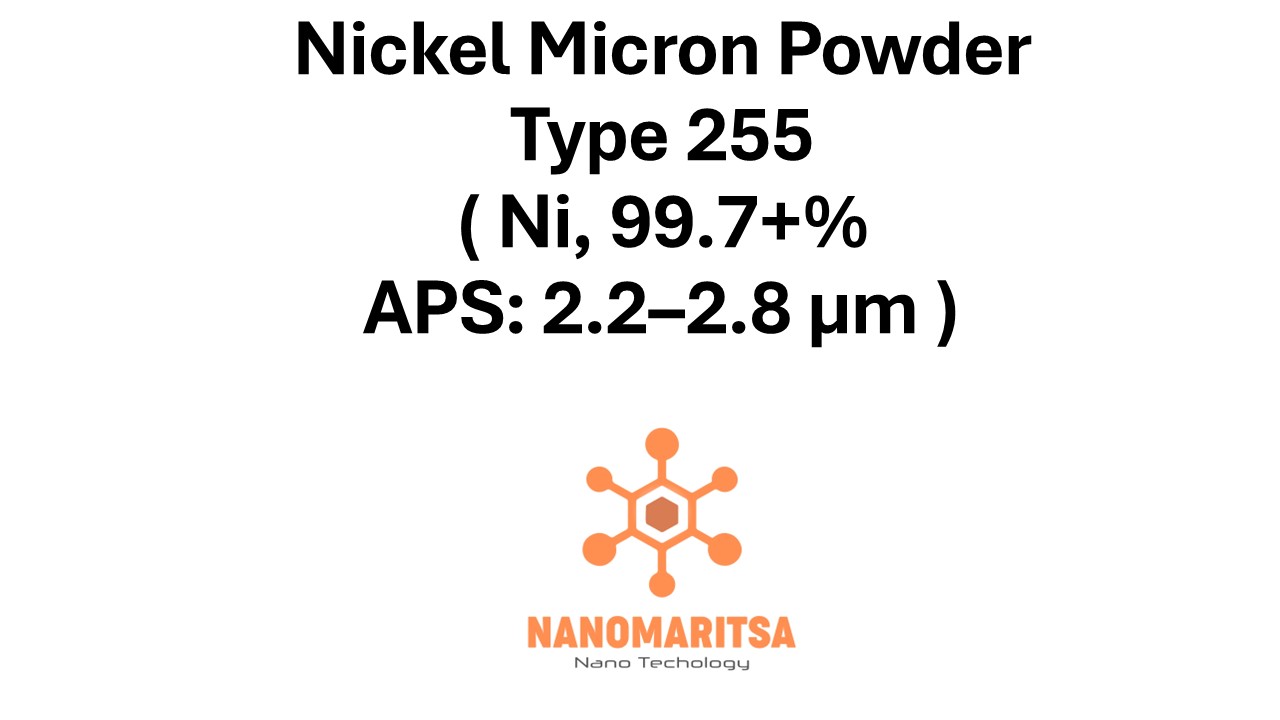Nickel Micron Powder Type 255 (Ni, 99.7+%, APS: 2.2–2.8 μm) is a fine-grade nickel powder distinguished by its high purity (exceeding 99.7%) and tightly controlled average particle size, typically between 2.2 and 2.8 micrometers. This refined particle distribution ensures enhanced surface area and uniform dispersion, both of which are crucial in processes like powder metallurgy, catalytic applications, and various electronic manufacturing techniques. Nickel’s well-known properties—corrosion resistance, strong mechanical performance, and reliable electrical and thermal conductivity—make this powder a preferred choice in industries such as aerospace, automotive, energy storage, and electronics.
- Key Properties
- High Purity (99.7+%): The elevated purity level helps reduce contaminants that could affect performance in critical applications, including aerospace components and electronic devices.
- Fine Particle Size (2.2–2.8 μm): The narrow particle size range leads to better control over chemical reactivity and uniform material properties, providing consistency in advanced manufacturing processes and catalytic reactions.
- Corrosion Resistance: Nickel naturally resists oxidation and corrosion, which is advantageous for components operating in chemically aggressive or high-humidity environments.
- Electrical & Thermal Conductivity: Nickel’s high conductivity supports efficient electron flow and heat dissipation—beneficial in battery electrodes, power electronics, and other heat-sensitive applications.
- Mechanical Strength: Nickel’s inherent durability at both ambient and elevated temperatures allows for robust, long-lasting parts in demanding conditions.
- Applications
- Aerospace and Automotive: Utilized in creating high-temperature alloys for engine parts, turbine blades, and exhaust systems, where it contributes to heat resistance and extended service life.
- Powder Metallurgy: Fine nickel powder aids in producing dense, homogenous sintered parts, improving both mechanical properties and overall process efficiency in industries like automotive and industrial machinery.
- Catalysts: Nickel is a key catalyst in hydrogenation and various chemical reactions. The fine particle size of Type 255 powder boosts surface contact, enhancing catalytic performance and reaction rates.
- Energy Storage and Batteries: Used in nickel-based battery chemistries (e.g., NiMH, NiCd) and as a potential additive in emerging battery technologies, nickel powder plays a critical role in electrode performance and stability.
- Electronics and Conductive Inks: Thanks to its conductivity, fine nickel powder can be deployed in conductive inks, EMI/RFI shielding materials, and electronic components that benefit from consistent current flow and minimized signal interference.
- Advantages
- Enhanced Surface Area: A fine particle size increases the active surface area, improving chemical and electrochemical reactions crucial in catalysis, batteries, and coatings.
- Uniform Dispersion: The controlled APS (average particle size) range facilitates homogeneous mixing, reducing agglomeration and ensuring consistent performance throughout the manufacturing process.
- Versatile Manufacturing: Whether it’s powder metallurgy, metal injection molding, or specialized coating techniques, this nickel powder integrates seamlessly into diverse production methods.
- Durability Under Stress: Nickel-based parts retain their strength at high temperatures and under corrosive conditions, lowering maintenance costs and extending product service life.
- Conductivity for Advanced Electronics: The powder’s purity and size distribution help maintain stable electrical and thermal conductivity—key in sensitive electronic and power system applications.
- Recent Trends and Research
- Improved Battery Chemistries: Nickel remains central to high-performance batteries, where research focuses on increasing energy density, reducing costs, and extending cycle life.
- Additive Manufacturing Expansion: As metal 3D printing evolves, fine nickel powders may see increased adoption, especially for intricate aerospace and medical device components that demand precision.
- Hybrid and Electric Vehicles: The shift toward electric mobility has spurred additional interest in nickel’s role in battery systems, as manufacturers seek materials that balance cost, safety, and performance.
- Sustainable Processing: Industry and academia are exploring more environmentally friendly mining, refining, and recycling practices, aiming to minimize nickel’s ecological footprint while meeting global demand.
- Advanced Corrosion-Resistant Alloys: Ongoing studies seek to develop novel nickel-based alloys with superior corrosion and oxidation resistance for applications in marine, chemical, and energy sectors.
- Future Prospects
- Next-Generation Energy Systems: With the push toward green energy and renewable resources, nickel’s importance in battery electrodes, fuel cells, and other clean technologies is set to grow.
- Innovations in Aerospace & Defense: Nickel-based superalloys will continue to be refined for use in ultra-high-temperature, high-stress environments, improving efficiency and performance.
- Additive Manufacturing Advances: As 3D printing techniques mature, the demand for ultra-fine, high-purity nickel powders that can produce complex geometries and high-integrity components is likely to increase.
- Circular Economy & Recycling: Efforts to enhance nickel recovery from end-of-life products and industrial scrap will become more critical, promoting both cost efficiency and environmental stewardship.
- Emerging Electronics & Catalysis: Nickel’s versatile properties will remain valuable in developing new catalytic processes, sensors, and conductive formulations, supporting broader industrial and consumer innovations.
By combining high purity, fine particle size, and excellent mechanical and chemical stability, Nickel Micron Powder Type 255 (Ni, 99.7+%, APS: 2.2–2.8 μm) meets the exacting standards of modern manufacturing and research initiatives. Its role in aerospace, automotive, catalysis, electronics, and energy storage is poised for further expansion as global industries continually seek reliable, efficient, and sustainable materials.
| Measurement (gr) | 100 grams, 500 grams, 1000 grams |
|---|






